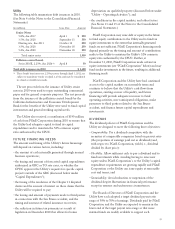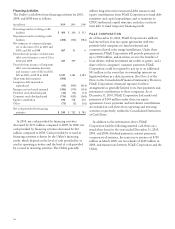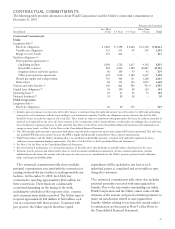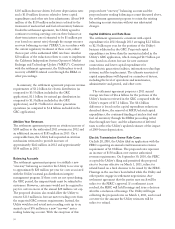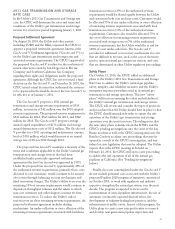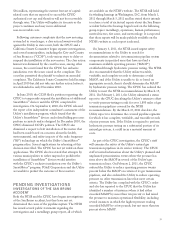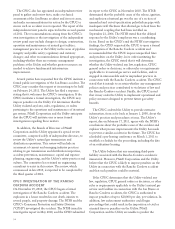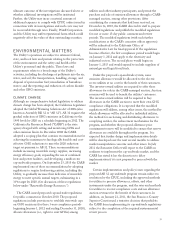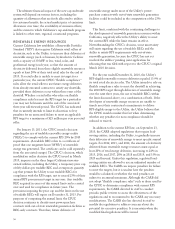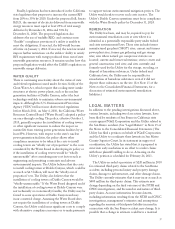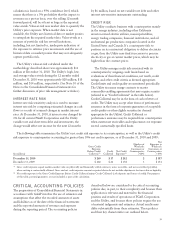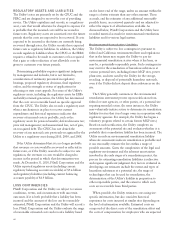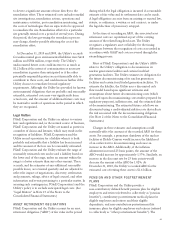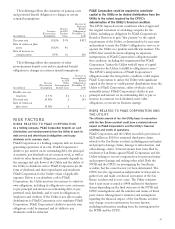PG&E 2010 Annual Report Download - page 37
Download and view the complete annual report
Please find page 37 of the 2010 PG&E annual report below. You can navigate through the pages in the report by either clicking on the pages listed below, or by using the keyword search tool below to find specific information within the annual report.$36 million, representing the current forecast of capital-
related costs that are expected to exceed the CPUC-
authorized cost cap and therefore will not be recoverable
through rates. The Utility will update its forecasts as the
project continues and may incur additional
non-recoverable costs.
Following customer complaints that the new metering
system led to overcharges, a class action lawsuit was filed
against the Utility in state court, both the CPUC and a
California Senate Committee began separate investigations,
and several municipalities, including the City and County
of San Francisco (“CCSF”), took various steps to delay or
suspend the installation of the new meters. The class action
lawsuit was dismissed by the court because, among other
reasons, the court found that the CPUC has exclusive
jurisdiction over the issues raised in the complaint. The
court has permitted the plaintiff to submit an amended
complaint. The California Senate Committee held hearings
in April 2010 but did not take any further action before it
was disbanded in early November 2010.
In June 2010, the CCSF filed a petition requesting the
CPUC to temporarily suspend the installation of additional
SmartMeter™devices until the CPUC completed its
investigation. On September 2, 2010, the CPUC released
the report of its independent consultant’s assessment of the
Utility’s installation program, which found that the
Utility’s SmartMeter™devices and related billing processes
perform accurately and as designed. In December 2010, the
CPUC dismissed CCSF’s petition. The CPUC also
dismissed a request to halt installation of the meters that
had been made based on concerns about the health,
environmental, and safety impacts of the radio frequency
(“RF”) technology on which the Utility’s SmartMeter™
program relies. Several applications for rehearing of this
decision were filed. The CPUC has not yet ruled on these
applications. The CPUC also has stated that attempts by
various municipalities to either suspend or prohibit the
installation of SmartMeter™devices would interfere
with the CPUC’s exclusive jurisdiction over the Utility’s
SmartMeter™program. PG&E Corporation and the Utility
are unable to predict the outcome of these matters.
PENDING INVESTIGATIONS
INVESTIGATIONS OF THE SAN BRUNO
ACCIDENT
Both the NTSB and the CPUC have begun investigations
of the San Bruno accident, but they have not yet
determined the cause of the pipeline rupture. The NTSB
has issued several public statements regarding the
investigation and a metallurgy group report, all of which
are available on the NTSB’s website. The NTSB will hold
fact-finding hearings in Washington, D.C. from March 1,
2011 through March 3, 2011 and has stated that it intends
to release a total of six factual reports about the San Bruno
accident before the hearings begin based on the following
group topics: metallurgy, operations, human performance,
survival factors, fire scene, and meteorology. It is expected
that these reports will be made publicly available on the
NTSB’s website as each report is released.
On January 3, 2011, the NTSB issued urgent safety
recommendations to the Utility to search for
documentation related to its transmission pipeline system
components in specified areas that have not had a
maximum available operating pressure (“MAOP”)
established through hydrostatic pressure testing. The NTSB
also recommended that the Utility utilize traceable,
verifiable, and complete records to determine a valid
MAOP, and if the Utility is unable to do so based on
appropriate records, then it should determine the MAOP
by hydrostatic pressure testing. The CPUC has ordered the
Utility to meet the NTSB recommendations by March 15,
2011. On February 1, 2011, the Utility submitted a status
report to the CPUC describing the Utility’s extensive effort
to verify pressure-testing records for over 1,800 miles of gas
transmission pipelines covered by the NTSB
recommendations. By the March 15, 2011 due date, the
Utility expects to determine the covered pipeline segments
for which it has complete, verifiable, and traceable records
of prior pressure tests. If the Utility is required to perform
hydrostatic pressure testing on a substantial portion of its
natural gas system, it could incur a material amount of
costs.
As part of the CPUC investigation, the CPUC’s staff
will examine the safety of the Utility’s natural gas
transmission pipelines in its service territory. The CPUC
staff reviewed information about the Utility’s planned and
unplanned pressurization events where the pressure has
risen above the MAOP in several of the Utility’s gas
transmission lines. On February 2, 2011, the CPUC
ordered the Utility to reduce operating pressure twenty
percent below the MAOP on certain of its gas transmission
pipelines, and also ordered the Utility to reduce operating
pressure on other transmission lines that meet certain
criteria. The Utility has complied with the CPUC’s order
and also has reported to the CPUC that the Utility has
identified a number of instances where it had either
exceeded MAOP by more than ten percent or had raised
the pressure to maintain operational flexibility, including
several instances in which the highest pressure reading
exceeded MAOP by a few pounds, but not more than ten
percent above MAOP.
33


